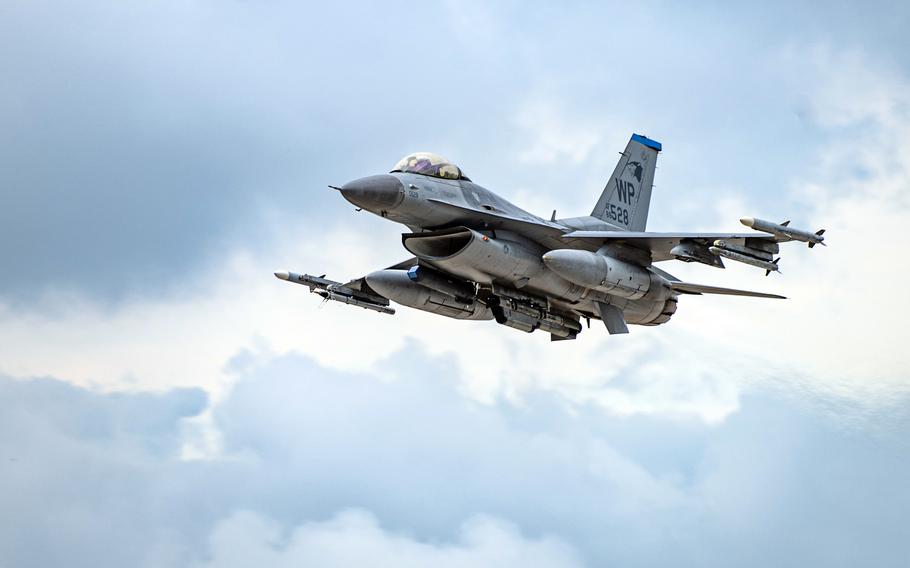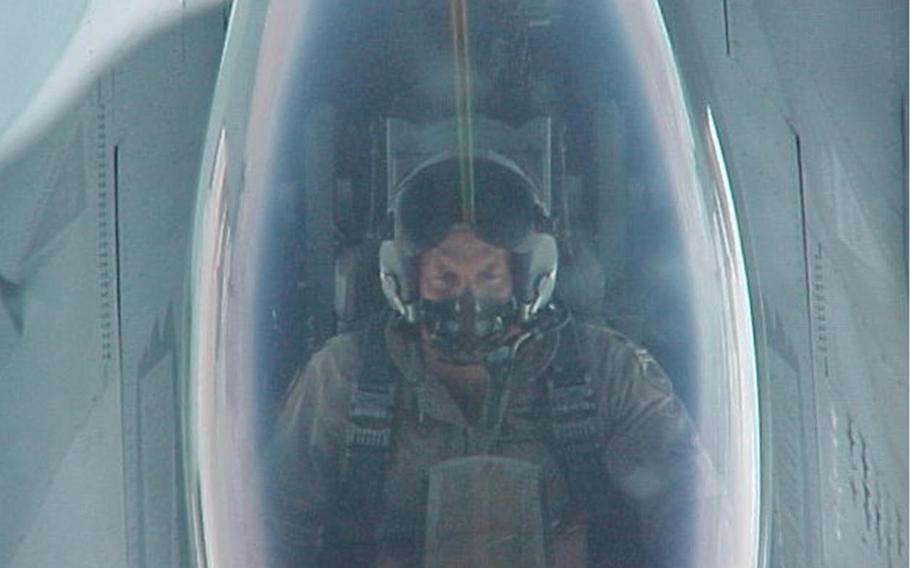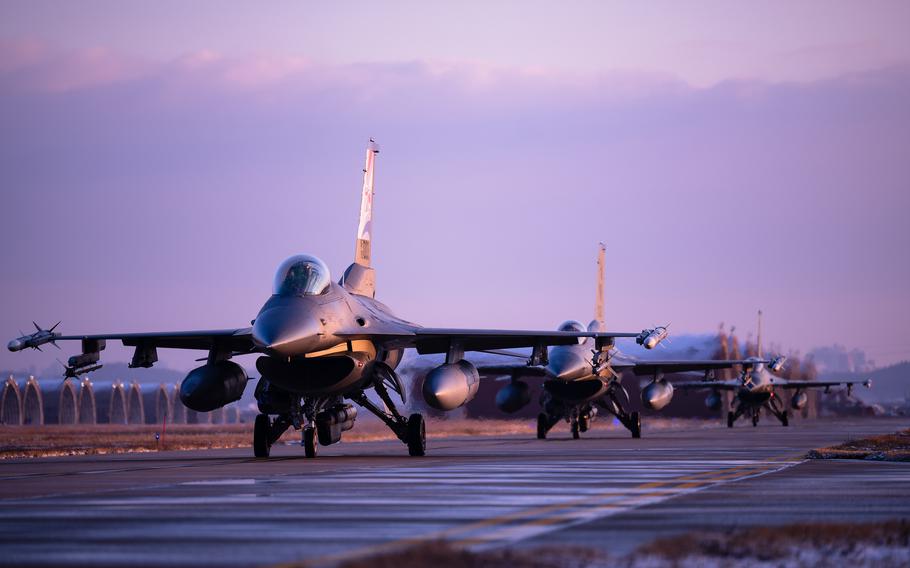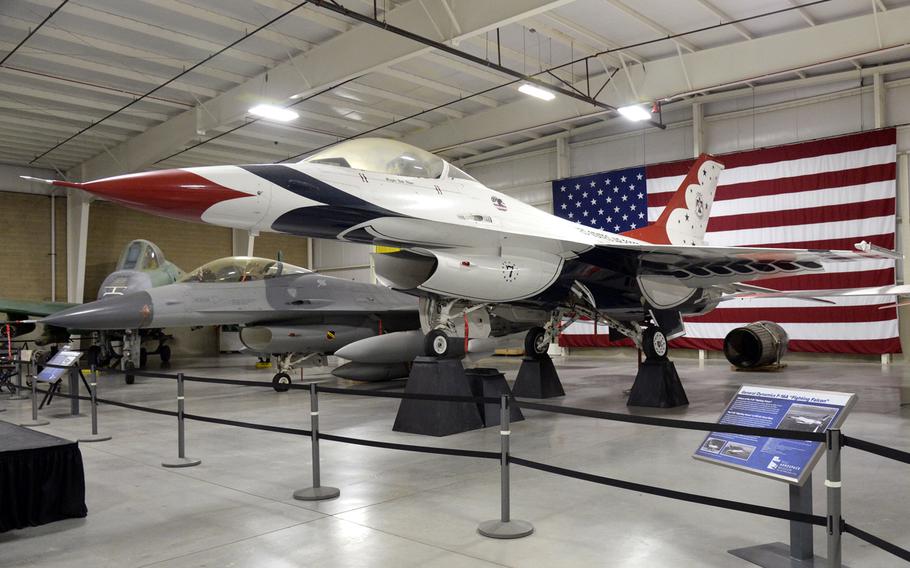
An F-16 Fighting Falcon assigned to the 35th Fighter Squadron takes off from Kunsan Air Base, South Korea, Sept. 27, 2023. (Karla Parra/U.S. Air Force)
Col. Matthew Gaetke first arrived at the home of the 8th Fighter Wing in South Korea 15 years ago as an Air Force captain assigned to fly the F-16 Fighting Falcon.
Today, he is back at Kunsan Air Base, this time as wing commander. Since that first tour, Gaetke has logged 2,200 flight hours, most of them in the F-16, which turned 50 on Feb. 2.
“The thing that you see in pictures of the F-16 that’s hard to appreciate is just how good the office window is,” he said during an interview Tuesday, referring to the bubble canopy that gives pilots of the multirole fighter a wide view of the world around them.
“Having that window in some amazing sunrises or seeing your wingman silhouetted against the morning sun on a thunder cloud — there’s things that you see that you wish you could describe for folks.”

Retired Air Force Lt. Col. Dan Hampton pilots an F-16 Fighting Falcon in this undated photo. (Dan Hampton)
Kunsan was the first U.S. air base overseas to receive the F-16, now a respected fighter the world over with a proven combat record.
A prototype developed by General Dynamics first flew on Jan. 20, 1974, an unplanned flight to avoid an accident on the runway at Edwards Air Force Base, Calif.
The prototype took to the skies again less than two weeks later for its first official flight.
The Air Force took delivery of its first F-16 in August 1978, according to a 2003 news release from current maker Lockheed Martin.
Today, approximately 3,100 F-16s are in service in 25 countries, with a 113-jet backlog on orders for six countries for the newest version, the Block 70/72, according to Lockheed Martin.
The fourth-generation warplane, built as a simplified fighter with reduced size, costs and weight, can pull up to nine Gs, more than most other fighters, according to the Air Force.
About 40 F-16s occupy the Kunsan flightline today. The compact fighter is the backbone of the 7th Air Force, headquartered at Osan Air Base, whose mission is to defend South Korea from North Korea, wing spokeswoman Capt. Kaylin Hankerson said by email Thursday.
As tensions increase on the Korean Peninsula with each ballistic missile test or artillery round fired by the North, the F-16 has flown increasing numbers of sorties, including alongside U.S. allies.
On Oct. 22, for example, two U.S. F-16s, two South Korean F-15K Slam Eagles and two Japanese F-2s escorted an Air Force B-52H Stratofortress bomber in the three countries’ first combined airpower demonstration.

F-16 Fighting Falcons assigned to the 80th and 35th Fighter Squadrons taxi before take-off at Kunsan Air Base, South Korea, Dec. 1, 2023. (Karla Parra/U.S. Air Force)
Modernized
The fourth-generation F-16 makes up about 50% of the Air Force fleet and has flown in every major U.S. conflict since 1974.
The Fighting Falcon, also known as the Viper by its pilots, is easily upgraded with new equipment to face evolving threats, according to Dan Hampton, a retired Air Force lieutenant colonel and former F-16 pilot who earned four Distinguished Flying Crosses with Valor in Kosovo, Iraq and the first Gulf War.
“What’s made it so successful is that it’s so adaptable,” he said by phone Saturday.
The jet was designed with modular components that could be replaced with the latest technology, Hampton said.
Modifying jets “used to involve pulling them into the factory and ripping their guts out,” he said.
The F-16, however, “was designed so extraordinarily well in the beginning that when new technology came along, when things needed to be added, essentially all you did was pull the boxes out,” Hampton said.

An F-16A Fighting Falcon flown by the Thunderbirds aerial demonstration team from 1983-1992 is on display in the Hill Aerospace Museum at Hill Air Force Base, Utah. (Todd Cromar/U.S. Air Force)
In 2022, the Air Force started “one of the largest modernization efforts” in its history with $6.3 billion in improvements to 608 F-16s.
The project included 22 upgrades, including installation of the Active Electronically Scanned Array radar and jam-resistant communications systems used by U.S., NATO and other allied forces.
“The first F-16 that flew 50 years ago looks nothing like these F-16s that we have on the ramp out here,” Gaetke said. “The cockpit looks very different than it did when I was here the first time 15 years ago.”
Diverse but challenging
The F-16 upgrades bore fruit, particularly during the onset of the 2003 Iraq War, when the fighters struck surface-to-air missile sites and provided close-air support.
A few days into the war, many of the U.S. F-15E Strike Eagles — initially designed to focus on air-to-air combat — were “sent home because the F-16s could do everything they were doing,” Hampton said.
The F-16s’ ability to provide air-to-air and air-to-ground support made it an “all-around beast” in combat, he said.
The American F-16s in Iraq would “go out and purposefully pick a fight with surface-to-air missiles and all the things that other airplanes avoid like the plague,” Hampton said.
The F-16’s diverse but challenging mission set appeals to some pilots, Gaetke said.
Although older than the fifth-generation F-35 Lightning II stealth fighter, the Fighting Falcon’s evolution over the past decades keeps it relevant in the Air Force.
The F-16s provide a “great introduction to the fighter mentality” and many of its pilots at Kunsan go on to fly F-35s, Gaetke said.